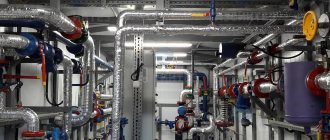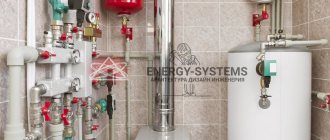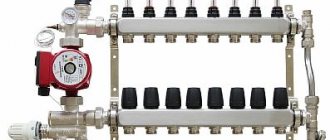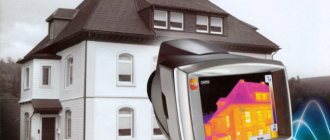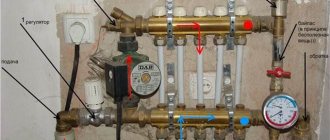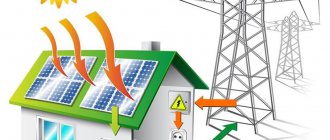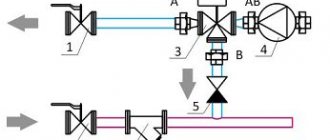Definition and purpose
To control energy consumption in an apartment building, thermal units are installed to record the main indicators of heat transfer. In addition to temperature, the volume and quality of thermal conditions are determined. Accounting units are a set of entire modules for carrying out the necessary measurements.
By monitoring the temperature of the coolant inside, you can adjust it to the required value
The role of such a unit in the normal operation of all building systems is primarily related to the control and recording of these devices included in its composition. Here are just some of the main reasons why it is built:
- Quality control of temperature conditions provided by the heating system.
- Accounting for temperature, pressure and other indicators for analysis and recording in regulatory documents.
- To correctly calculate the fees charged to consumers in favor of the heat energy supplier.
- To check and regulate the efficient operation of the heating system in a building.
The smooth operation of such a unit helps the homeowner to effectively spend resources and money on home maintenance, as well as set optimal prices for paying for their services.
The presence of a reliable control center is simply necessary for the smooth operation of the structure.
This video will tell you how the system of heat metering units in your home works:
Installation Features
Installation of a heat metering unit in an apartment building is divided into several main stages:
- Study and analysis of the object.
- Creation and approval of the project.
- Assembly and adjustment.
- Organization of monitoring.
- Providing a diagram of the heating unit of an apartment building to the heating supply organization and obtaining an operating permit.
The cost of the procedure depends on the characteristics of the object and can vary significantly. If it is necessary to replace the thermal energy metering unit, the sequence of actions is approximately the same. The most critical stage is the development of the project and selection of equipment. Naturally, the installation of thermal energy metering units must be carried out with maximum care and precision. However, if the initial calculations turn out to be erroneous, even high-quality, expensive devices will not provide the required accuracy of readings.
When a heating unit is installed in a private house, the coordination scheme may be slightly different. In any case, going through the authorities on your own will require serious time investment. As a rule, the installation of thermal energy metering units includes this service. Decide for yourself what is preferable to you - pay a little extra or save through your own efforts. However, keep in mind that it is much easier for experienced representatives of a construction organization to obtain permission than for an individual.
Automation of heat metering units makes it possible to organize remote data collection from meters, which greatly simplifies facility monitoring. UUTE maintenance should be trusted to professionals. Independence in this matter, as in the installation of heat metering units in Moscow, can lead to significant financial losses. If equipment breakdown is not noticed in time, repairs may take a long time, and all this time you will be overpaying for unused heat. If you are interested in whether it is possible to install UUTE on the heating unit of your home and other questions on this topic, you can get answers to them on our website.
Hello!
Short
Apparently, the heat meter was installed by Heating Network in accordance with Part 12 of Article 13 of the Federal Law of November 23, 2009 No. 261-FZ, and in accordance with paragraph 38(1) of the Decree of the Government of the Russian Federation of August 13, 2006 No. 491 cost on receipt.
The management company had to hold a general meeting at which the owners should decide to increase the tariff for current repairs and maintenance of common property by the amount necessary to service the heat meter.
This was not done. The management company does not deal with the heat meter, since the costs for it are not included in the estimate.
You need to conclude an agreement with the same “Heating Network” (or another company - if desired, “Heating Network” does not have the right to refuse to conclude this agreement) for its maintenance.
If the meter breaks down, a 3-month fee is charged based on the average consumption for the heating period, and then according to the standard.
Details
According to paragraph 5 of Article 13 of Federal Law No. 261-FZ of November 23, 2009, owners of residential buildings or premises in multi-apartment buildings are required to ensure that such houses are equipped with both collective (common house) and individual (with the exception of heating) with metering devices (until January 1, 2015, with natural gas metering devices).
In accordance with paragraph 5 of the Rules for the maintenance of common property in an apartment building, approved by Decree of the Government of the Russian Federation of August 13, 2006 No. 491, a common house meter refers to common property, the acquisition and installation of which is carried out at the expense of the owners, in proportion to the share in the right of common property for common property in this house. Installation of individual metering devices in residential premises is carried out by the owner of the premises at his own expense. If the owners of premises in an apartment building have not independently ensured that such a house is equipped with common building meters for metering the utility resource used, then in accordance with Part 12 of Article 13 of Federal Law No. 261-FZ, the resource supplying organization is obliged to do this by July 1, 2013. The owner is obliged to reimburse the costs of installing a common house metering device for the specified organization in the amount proportional to his share in the right of common ownership of common property, in accordance with paragraph 38 (1) of the Decree of the Government of the Russian Federation of August 13, 2006 No. 491. The owners of premises in the apartment building pay the costs of the RSO equal in installments over a period of five years from the date of installation of the meters, provided that they do not express their intention to pay such expenses in a lump sum or with a shorter installment period. In accordance with paragraph 38(1) of the Decree of the Government of the Russian Federation of August 13, 2006 No. 491, property owners are required to pay the costs of installing a collective metering device on the basis of an invoice issued by RSO (if the corresponding amounts were not taken into account as part of the fee for the maintenance and repair of residential premises and (or) as part of mandatory payments and (or) contributions established for members of the HOA). Moreover, the RSO must indicate in the invoice for each owner both the total amount of expenses for installing the metering device and the share proportional to the share in the right of common ownership of the common property to be paid by this owner.
In case of “breakdown” of the heat meter.
59. Payment for a utility service provided to a consumer in a residential or non-residential premises for the billing period is determined based on the calculated average monthly consumption of the utility resource by the consumer, determined by meter readings for a period of at least 6 months (for heating - based on the average monthly consumption for the heating period volume of consumption), and if the period of operation of the metering device was less than 6 months, then for the actual period of operation of the metering device, but not less than 3 months (for heating - at least 3 months of the heating period) in the following cases and for the specified billing periods: a )
in case of failure
metering device
previously put into operation or the expiration of its service life, determined by the period of time before the next verification - starting from the date when the specified events occurred, and if the date cannot be determined , - then starting from the billing period in which the specified events occurred until the date when the accounting of the utility resource was resumed by putting into operation an individual, general (apartment), room metering device that meets the established requirements, but no more than 3 billing periods in a row for a residential premises and no more than 2 billing periods in a row for non-residential premises;
Every home owner is faced with the need to pay for utilities. In order to have water, gas, electricity, heat and other amenities in the apartment, you have to fork out a significant amount every month. Many residents try to reduce payments as much as possible by installing individual meters that record water and gas consumption in a specific apartment. But apparently, the native state does not plan to make life easier for citizens.
Proof of this is the legislative enshrinement of the obligation to pay for the installation of a single heat energy meter in your home. What is it, what is it for, is it possible to refuse to install it and who is it useful for? The article contains answers to all questions.
Dear reader! Our articles talk about typical ways to resolve legal issues, but each case is unique.
If you want to find out how to solve your particular problem, please use the online consultant form on the right or call.
It's fast and free!
Purpose
A thermal energy metering unit is being organized for the following purposes:
- Controlling the rational use of coolant and thermal energy.
- Control of thermal and hydraulic modes of heat consumption and heat supply systems.
- Documentation of coolant parameters: pressure, temperature and volume (mass).
- Carrying out mutual financial settlements between the consumer and the organization engaged in the supply of thermal energy.
Why is an accounting system necessary?
Installation of a thermal energy metering unit is carried out at the entrance of pipes into an apartment building in order to perform the following functions:
- checking and adjusting the use of coolant and heat energy;
- adjustment and testing of heating and hydraulic systems;
- reading and archiving coolant data (volume, pressure, temperature)
- carrying out monetary settlements between the consumer and the heat energy supplier, after checking the received data.
Its main goal is to change the characteristics of the internal coolant and monitor energy consumption. What does this mean? Before the coolant enters the consumer’s convector or radiator, the heating unit reduces its pressure and temperature.
If you observe, you will notice that it is impossible to get burned on the radiators and pipes of the heating system. This point is useful not only for consumers, but also directly for the heating system itself. Now the metal pipeline is being replaced with polypropylene or metal-plastic. But such pipes do not tolerate high pressure and temperature quite well.
Here are several regulated operating modes of the heat metering unit:
- 110/70;
- 130/70;
- 150/17.
These parameters indicate what maximum and minimum temperatures of the coolant in the pipes are allowed. A thermal energy meter is installed on each metering unit.
Device
A standard UTE project requires a certain list of mandatory elements and includes the following mechanisms:
- Shut-off units. The resource supply is cut off.
- Mud trap or filters. They prevent the penetration of suspended matter and protect other devices and the overall system from damage and clogging.
- Thermal converter, which is connected to the meter. The device is most often welded into the inlet pipe.
- Thermal energy metering device (computer). Modern models solve a whole range of problems, from measurement to calculation of various parameters.
- Pressure meter. Installation is required if a multi-apartment building consumes more than 0.5 Gcal/hour of heat.
- A simple pressure gauge and a liquid thermometer are installed separately. These are auxiliary elements for service personnel.
- Flow converter, after which the valve is placed.
The system is installed on the incoming pipeline. On the return section there will be a mud trap and a temperature sensor.
In addition to the units traditional for the distribution system, the centralized heat energy metering unit is equipped with a computing unit, as well as a printer and a telemetry module for data transmission
Use of UTE for property owners in relation to heating payments
After installation of metering devices, payment is made during the period of provision of the relevant services. The length of the heating season varies depending on the season, but on average it is about 7 months. You do not have to pay for the whole year, but during the provision of services.
Until the installation of UTE, payment for heat supply is charged according to accepted standards, which for homeowners is associated with a significant increase in payments. The use of devices for recording the supplied resource allows you to save money for payers.
At the legislative level, the responsibility of a management company that has not taken sufficient measures regarding the need to install a heat meter is established. The fine is:
- for organizations – up to 150 thousand rubles;
- for officials – up to 30 thousand.
There are also administrative fines for public utilities who unreasonably refuse to use UTE in comparable amounts to those indicated above.
If residents refuse to install the device, they will be required to do so by court order, according to the statement of claim filed by the utilities. Additionally, you will have to reimburse court costs and pay the assigned fine.
The use of UUTE allows property owners to obtain obvious advantages, similar to the situation with the use of any other metering devices. And the necessary initial costs for the purchase and installation of equipment will definitely pay off, due to the subsequent reduction in costs for paying for the supply of heat.
Composition and location
Apartment buildings can have different configurations. Because of this, the UUTs may be different in appearance and design from each other.
Such units can also be installed for a private house if it is connected to a central heating system
However, the main elements are included in each node:
- Shut-off and control valves. Devices and devices for regulating and completely shutting down various components of the heating system.
- Heat meter. The main measuring device, which may differ in design, but is required to give readings of the main parameters of heat supply.
- Sump. Garbage collection site. The main purpose of this device is to prevent foreign objects and substances from entering the heating system.
- Flow meter. A device that takes into account coolant flow and helps regulate its supply.
- Elevator. The elevator heating unit serves to regulate the temperature of the coolant. In this device, by mixing hot and cooled coolant (return), adjustment occurs to standard values.
- Thermal sensor. A measuring device for recording the temperature of the coolant when returning from the heating system.
- Auxiliary equipment. Many control centers are provided with additional devices and units. Modern technologies can significantly expand control capabilities.
The main requirement for the arrangement of instruments and all components of the control system is maximum accuracy and efficiency. Therefore, there are certain rules for the sequence and location of the main nodes. Here are just a few of them:
- Place metering devices at the interface, as close as possible to valves and coolant supply regulators.
- Prohibition on the installation of additional pipeline outlets that bypass sensors.
- The temperature sensor on the return line is placed in front of the valve on the outside.
- Place instruments so that there is good visual access for taking instrument readings and servicing them.
This is interesting: the principle of a two-way valve for heating.
Following the basic instructions, it will not be difficult to equip a heating metering unit if you have all the necessary components for its operation.
The layout and sequence are thought out in advance, making the necessary drawings and calculations.
Basic diagrams of heating systems
So, before considering the diagrams of thermal units, it is necessary to consider what types of heating system diagrams there are. Among them, the most popular is the top distribution design, in which the coolant flows through the main riser and is directed into the main pipeline of the top distribution. In most cases, the main riser is located in the attic, from where it branches into secondary risers and is then distributed to the heating elements. It is advisable to use a similar scheme in one-story buildings in order to save free space.
There are also diagrams of heating systems with bottom wiring. In this case, the heating unit is located in the basement, from where it comes out with warm water. It is worth noting that, regardless of the type of circuit, it is recommended to also place an expansion tank in the attic of the building.
Essential elements
The thermal unit consists of a set of devices and metering devices that provide the performance of one or several functions at the same time: storage, accumulation, measurement, display of information about mass (volume), amount of thermal energy, pressure, temperature of the circulating fluid, as well as operating time .
As a rule, a heat meter is used as a metering device, which includes a resistance thermal converter, a heat calculator and a primary flow converter. Additionally, the heat meter can be equipped with filters and pressure sensors (depending on the model of the primary converter). Heat meters can use primary transducers with the following measurement options: vortex, ultrasonic, electromagnetic and tachometer.
What does a utility bill look like?
What does a utility bill look like?
A housing and utility bill looks like this: it is a written document that lists the services for which a fee is charged. Tariffs are also indicated there.
The rent act has the following content:
- Indication of the payer.
- Address and location of residential premises.
- The name of the service provider and its bank details.
- QR code.
- Data on the services provided.
- Tariffs that are applied during calculation.
- Total amount to be paid.
Depending on the management company, the receipt may also include services for garbage removal, sewerage, general house needs, heating, etc.
Schemes of metering units
Several options for creating a system of heating points are popular. Hot water connection diagrams:
- Sequential two-stage. A classic solution in which there is a division into two sections. The first is the inlet pipe of the heating system, and the second is the return pipe. The convenience of the scheme is that there is no need for network water. There are a number of significant disadvantages, among which is the need to implement an automated control system to properly distribute heat.
- Parallel single stage. Standard option, characterized by simplicity. The main problem is the significant consumption of network water, which is used to create a water supply. Connection principle: hot water supply pipes are connected in parallel to the heating system.
- Mixed two-stage. A universal solution that allows you to quickly make the necessary settings. Unlike the previous version, there is a serial connection, and the implementation principle is almost identical to the first version.
Much depends on the characteristics of the apartment building and the functioning heating system.
Why are we required to install heat meters?
For many, it is unclear why spend money on installing expensive equipment for recording consumption volumes, if almost every apartment has individual devices. According to utility workers, this measure is beneficial to residents of apartment buildings:
- Allows you to take into account the consumption of resources in a particular house and distribute it evenly among all residents. The question immediately arises: why was the individual counter so bad? One person uses fifty cubic meters of water, while another is content with five. Why, as a result, should the second person pay for someone else besides himself?
- During the period when hot water is turned off, the device allows you to calculate indicators only based on cold water costs, therefore, the payment for hot water supply during this period is reduced.
- Since consumption in a specific home is recorded, in the event of a loss of part of the resources on highways due to the fault of supply companies, citizens do not need to compensate for losses from their own pockets.
- The meter will detect leaks in water and heat supplies.
- Allows you to monitor the compliance of supplied resources with established standards.
Do not forget that all resource costs for maintaining the local area, for example, watering lawns, will also be recorded with new equipment and included in payment receipts.
Heat meter functions
Any type of device must perform the following tasks:
1. Automatic measurement:
- Duration of work in the error zone.
- Operating time with supply voltage applied.
- Excessive pressure of liquid circulating in the pipeline system.
- Water temperatures in pipelines of hot, cold water supply and heat supply systems.
- Coolant flow in hot water supply and heat supply pipelines.
2. Calculation:
- The amount of heat consumed.
- The volume of coolant flowing through the pipelines.
- Thermal power consumption.
- Differences in the temperature of the circulating fluid in the supply and return pipelines (cold water supply pipeline).
Types of heat meters depending on the measurement method
Currently, the following types of heat meters are widely used:
- Mechanical operating principle or tachometer. The most common modification of heat metering devices. There are vane or rotor (turbine) ones. Quite easy to use and does not require electrical costs. They work thanks to an impeller or rotor and reciprocating fluid movement;
Important! Mechanical heat meters are demanding of the coolant; the water must be clean. The device is equipped with an additional filter element, since its contamination directly affects the accuracy of the readings.
- Electromagnetic. The operating principle is based on interaction with electric waves of the coolant. Of all the presented categories, these metering devices are the most accurate. The disadvantage of the device is its use in horizontal thermal systems;
- Ultrasonic. Thermal energy is measured by measuring the length of the ultrasound signal passing through the coolant. The meters are installed in pairs, opposite each other. They also differ from each other according to: frequency, time, correlation and Doppler principles of operation. Used in open and closed thermal systems;
- Vortex type. They create a vortex flow in the liquid, due to their location on the path of coolant movement, with subsequent recording of the formation and disappearance of magnetic field vortices. It is used in vertical and horizontal heating systems.
Important! Vortex heat meters require straight pipelines, since the quality of measurements directly depends on the composition of the moving hot liquid, its speed and the presence of air masses in it.
Payment options for meter installation
The methods of concluding an agreement with a resource-providing company for the installation of a device and payment for it depend on who exactly initiated this process:
- Sometimes the residents themselves come up with a proposal to install equipment, realizing that by law they have no choice. Most often this happens in HOAs. The chairman gathers the members of the partnership and invites them to vote for or against the installation. The decision is considered adopted by a majority vote. If a positive verdict is reached, then even those who were against are required to participate in collecting funds. If there is a certain financial base in the house account, then funds can be taken from there. If not, citizens collect the required amount additionally. Both the HOA members themselves can enter into an agreement for the installation and maintenance of accounting equipment, or they can entrust this to the management company.
- House management workers notify residents of the need to equip the house with new equipment. They provide information about the installation company and the upcoming financial costs. Payment options are offered. The most common option is from a fund for maintenance and major repairs. If this is not enough, you will be asked to additionally pay for the cost of installation work and the device itself.
- An organization engaged in resource provision offers to purchase a metering device from them and enter into an agreement for its maintenance. This option is especially convenient when residents do not have the opportunity to immediately pay for the work in full. In this case, they may be given an installment plan for several years.
The procedure for installing a thermal energy metering unit
Work on installation, commissioning and startup of the system is carried out in the following order:
- Inspection of the premises and determination of the scope of work for a specific house;
- Development of project documentation with subsequent acceptance of the project;
- Installation work with equipment (insertion and electrical installation activities);
- Commissioning (programming and testing the network functionality);
- Conclusion of an agreement with subsequent registration on the balance sheet of the heat service company.
What to do if you received a receipt
In accordance with the standards specified in Federal Law No. 261, which was adopted on November 23, 2009, the owners of serviced facilities must independently bear the costs necessary to install measuring equipment.
If the owner does not have the opportunity to immediately pay the full cost of metering devices and installation work, the company to which energy resources are supplied must provide him with an installment plan for up to five years.
In this case, the owner’s share, which must be transferred by him for the installation of common house equipment, will be indicated in the receipt for utilities in equal parts over the next five years.
In addition to the cost of the device itself, in this case you will also need to pay additionally the interest provided for the provided installment plan in accordance with the refinancing rate established by the Central Bank.
Installation and installation of energy metering units - procedure
Installation of metering units at sites involves two areas of work: cutting thermomechanical parts into pipes and carrying out electrical installation work.
The result of all actions is the connection of sensors and flow meters to the computer. After this, the computing unit is launched. The next step is to debug all connected modules. It is carried out using software configuration of the computer and subsequent testing of the system. The unit is handed over after successful completion of the inspection.
Procedure for installing metering units:
- Drawing up design and estimate documentation for a heat metering unit
- Coordination of the project with the supplier company
- Design of the device configuration
- Production of unit modules according to existing drawings
- Insertion of modular blocks into existing networks
- Electrical installation and debugging work
- Delivery of the finished project to the customer
What devices does the energy metering unit consist of?
Based on the heat consumption characteristics of a particular facility, the number of metering units can be more or less. All nodes are connected using cable routes that lead from the devices to the computer. The calculator, as a rule, is located in the instrument cabinet; it is used to calculate the amount of thermal energy consumed when recalculating instrument readings.
It is also sometimes equipped with a GPRS transmitter, which, using a cellular network, transmits, upon request (or on a schedule), the readings of all connected devices to the water supplier, and, if the necessary settings are available to the transmitters, to the consumer. As a rule, these readings are verified once a day. This type of data transfer is called dispatching. The consumer can also check the readings at any time by simply opening the cabinet and viewing the data displayed on the electronic display of the computer.
Thermal energy metering unit is not one device, but a complex of devices. Installation of uute is necessary for metering and regulating energy and adjusting the amount of coolant inside. Systems serve to register and control parameters. Installation of this equipment is done in the basement of high-rise buildings on heating pipes.
Main parts of equipment:
- Shut-off valves.
- Sensors for monitoring pressure and temperature in the system.
- Shut-off valves.
- Flow, temperature and pressure transducers.
- Calculator.
The heating unit, the installation of which is initially designed for implementation in the communal systems of apartment buildings, is created using a whole complex of various devices and equipment. Such a device can serve one or several functions, which are:
- Measuring the amount of thermal energy, its pressure, mass, volume and temperature of the liquid that passes through the pipeline during operation.
- Collection and archiving of data on local media.
- Displaying information on metering devices.
Based on the data provided, the functioning of heating equipment in apartment buildings is checked, adjusted and serviced.
A metering device is a device such as a meter, the circuit of which includes:
- Primary flow transducer.
- Heat calculator.
- Resistance thermal converter.
Based on the type of primary transducer used (electromagnetic, tachometer, ultrasonic or vortex measurement option), the heat meter can include filters and pressure sensors in its device.
Maintenance, repair and installation of UTE on the receipt - what is it?
UUET stands for Heat Energy Metering Unit and is a technical system consisting of measuring instruments, devices for metering thermal energy, the volume of its consumption, devices for monitoring and recording coolant parameters. This term is defined in Government Decree No. 1034 of November 18, 2013 “On commercial metering of thermal energy and coolant.”
But it should be noted that installing a heat metering unit is not the desire of the residents of the house; it is an obligation stipulated by legal norms. Therefore, the costs of its installation fall on the wallet of apartment owners and are reflected in the receipt for utilities.
Not all residents understand why it should be installed in an apartment building, but utility workers assure that in the end the benefits will become obvious. And there are several reasons for this:
- UUTE allows you to take into account the consumption of consumed resources for a specific house. In case of heat loss on the main line due to the fault of the supplier, losses will not be calculated from the consumer, but only actual costs will be taken into account.
- It becomes possible to control the quality of the supplied resource and its compliance with standards, to identify leaks and losses.
- The device makes it possible to record costs only for cold water during hot water supply outages.
The UUTE installation itself consists of the following data:
- the cost of the entire system of instruments and devices;
- installation of equipment.
The cost of installation directly depends on the condition of the pipeline in the house. Insertion may require upgrading them or removing part of the existing communications in order to make a proper installation. This can significantly increase the financial burden on the owners of apartments in the building and the amount in the receipt may differ in each of the residential buildings.
Who generates receipts for housing and communal services payments?
There are several aspects to consider when answering this question. Thus, according to the law, in an apartment building, receipts for payment of utility services are sent and generated by management organizations. They are authorized to calculate the consumption of the following housing and communal services:
- for water supply;
- per apartment (depending on the number of persons registered there);
- for major repairs, etc.
Citizens receive separate receipts for gas and electricity supplies. This is due to the fact that these organizations are direct suppliers of utility services, and therefore charge directly.
Heat meter
The heat meter is the main element of which the thermal energy unit should consist. It is installed at the heat input into the heating system in close proximity to the balance sheet boundary of the heating network.
When installing a metering device remotely from this boundary, heating networks add losses in addition to the meter readings (to account for the heat that is released by the surface of pipelines in the area from the balance separation boundary to the heat meter).
UUTE - special payment
Since the cost of the meter and its installation according to the Housing Code are not included in housing and communal services, although they are included in the receipt as a separate line, this payment has a number of features:
- the amount is not included in the total debt for payments for housing and communal services if the tenant does not pay extra or does not pay at all;
- there are no penalties for this payment;
- the payment has a separate barcode;
- the amount of payment is determined not by the management organization, homeowners association or municipal authorities, but by the heating network enterprise itself.
However, you must deposit money on this line of the receipt. If this is not done, they will be recovered through the courts. And then penalties and legal costs will be calculated.
About the author of the article
Yulia Didukh Accountant, commercial lawyer, editor-in-chief of the channels “Legal Council”, “Veteran of Labor” and “Man in Uniforms at School” on the Yandex platform. Zen
Tips and tricks for installing UUTE
The main recommendation when installing heat metering units is the requirements for the human factor.
The estimate for the entire project for a specific structure, as well as further installation of equipment, must be made by specialists with specific knowledge and skills in this field. In this case, common property will last much longer.
Sources
- https://kaminguru.com/sistema-otoplenija/uzel-uchjota-teplovoj-jenergii.html
- https://FB.ru/article/220674/teplovoy-uzel-uzel-ucheta-teplovoy-energii-shemyi-teplovyih-uzlov
- https://4schetchika.ru/otoplenie/uzel-ucheta-teplovoy-energii-ustanovka-uute-shemy/
- https://www.tproekt.com/chto-takoe-uzel-ucheta-teplovoy-energii/
- https://ests.msk.ru/teplosnabzheniye/uzly-ucheta/montaj-i-ustanovka
- https://nedexpert.ru/vse-o-nedvizhimosti/ustanovka-uutje-v-kvitancii-chto-jeto-takoe/
[collapse]
